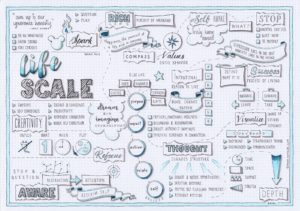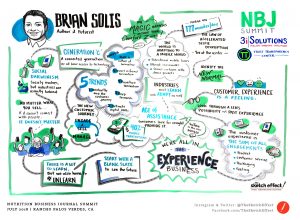
These days, we’re running fast…sometimes too fast. Our social networks keep us connected, but in some ways they’re also pulling us away from our center. Our social streams feed us information about our friends, family, events and even the latest viral videos or trends, but the currents too can overwhelm us.
In a time when multitasking is just a way of life and communication is always on, I often wonder how distorted our perspective becomes until we realize clarity is paramount to productivity. Think about it for a moment. We expect immediate responses to our texts, emails, and DMs yet we grumble at having too many messages to which we need to read and respond. We may in fact be our own worst enemy not the technology we often blame for our state of information overload. For every message you send, it seems that in an electronic game of hot potato, two always return. Connectedness comes at a very real human cost.
As we stray away from our comfort zone, we by default discover comfort by creating a new center. But that center requires consideration now and over time to ensure that we’re not only centered, but also moving along a path that takes us in a desirable direction. Seeking balance is more important than we might realize. Finding it may prove elusive for many, but pursuing balance and tracking toward a chosen destination is essential.
I spent some time with good friend Esteban Contreras where we discussed of course the latest books and my research at Altimeter Group. But, I also took it as a moment to reflect on the balance between professional and personal aspirations. I wanted to share the conversation with you here…
Esteban Contreras: Your book Engage further established you as a thought leader. What’s the story behind that book?
Brian Solis: Believe it or not, Engage has an interesting back story behind it… one that I rarely tell.
In 2007, I published the original Social Media Manifesto online to show exactly how businesses would benefit from strategic social media initiatives. It was huge.
But my first best-selling book was actually Putting the Public Back in Public Relations with Dierdre Breakenridge. We set out to show businesses how important the role of the public would become in marketing, advertising and customer service. I was about to tackle writing the follow up to the book, but noticed something in the process of promoting the last book…brands were embracing social media in a rather anti-social manner. They were using new tools to market in old ways. It was time to show businesses that social media was about meaningful and beneficial engagement on both sides.
I brought the idea to a good friend of mine and was given the green light to immediately begin writing it. However, it was written under a different title and also featured a different cover. The book was originally called The Social Media Manifesto. At the 11th hour, I changed my mind. I wanted the book to be less about social media and more about engagement where social media became the channel for building relationships, gaining insights, and fostering loyalty and advocacy. Of course, I addressed commerce and ROI as well, but I did so in a way that aligned business objectives with customer expectations. This lead to an entirely new name, cover, and also to the inclusion of Ashton Kutcher for the book’s foreword.

Social Media Manifesto: Original cover design
Another side story about the book is that it actually exists in two unique forms. The first edition was big. It’s size and density neared text book status. That was its goal however, to become the reference manual for social strategists. When it came time to publish the book in paperback form, I was asked if I wanted to make any changes. The publisher probably had a few updates in mind, but instead I took the opportunity to completely revise the book. I cut chapters, I cut blocks of text, I rewrote sentences and I added new experiences and lessons learned. The “revised and updated” edition is now commonly referred to as Engage 2 (note, not 2.0).
EC: The End of Business As Usual, has also been a great success. Do you see yourself following up with a fourth book at this point?
Solis: You never know.
The End of Business as Usual is an important book and I will support it for years to come. It’s not a book about social media. It’s a book for business executives to see how consumer behavior is changing, how technology impacts decision making, and how the rise of connected consumerism will impact the bottom line. Executives don’t care about Facebook or Twitter or smartphones for that matter. They care about objectives and meeting or exceeding them. To engage the connected customer requires a different approach.
Businesses must become adaptive in order to survive what I call Digital Darwinism, the phenomenon where evolution of society and technology evolve faster than the ability to adapt. Businesses are and will continue to fall because they focus on optimization, efficiencies, profits, and not on innovation and transformation to compete for tomorrow’s customer. This is a message that’s more important than ever before and this book shows executives how to recognize new opportunities and lead new and lucrative business strategies from the top down.
It’s also written for new media and social strategists who are fed up with the fear and skepticism that deflates their ballooning ideas. For everyone that asks them about ROI, the answer should be, “here, read this book.”
EC: Tell us about your experience at Altimeter Group and your particular role as Principal.
Solis: My work at Altimeter Group is both rewarding and eye-opening. I often say that we cannot possibly become “gurus” or experts of any medium that evolves faster than the ability to master it. I work with business executives and social strategists to bridge the gap between business objectives and social media strategies. Once the data is collected and analyzed, once internal conversations are transcribed and dissected, you start to see opportunities to bring people, departments, and thinking together. The work then becomes about recognizing new opportunities, direction, and the change necessary to create alignment toward new directions.
The research that we do helps us capture a state of “what is” and when combined with experience and the vision of the other analysts in the firm, you can start to chart a map to what “should be.”
EC: Beyond your work at Altimeter, you continue to be an avid blogger, content producer, speaker and event organizer. What would you say is the secret to maintaining balance in life?
Solis: The strive for balance is a journey and not a destination. Balance is less like spinning plates and more like running your finger around the rim of partially filled crystal bowls with varying depths of liquids. Each singing bowl makes a unique sound and as a result, music to “one’s” ears. When we think about the spinning plate metaphor, we think about how our quest for balance affects those around us as well as our pursuit to keep everything spinning simultaneously without falling and breaking. When you think about the bowls, you make music, the music you like, by bringing together different sounds. And it’s different every time. The point is, balance is a state of what’s important to you and those around you in the moment.
Connect with me: Twitter | LinkedIn | Facebook | Google+
The End of Business as Usual is officially here…







Very nice interview and well said Brian. Not that we would expect any less from you. 🙂 I love the “singing bowl” analogy.
Thank you so much Sandy!
thank you for the interview. enjoy very much.
You’re welcome!
Great post,as always. Music to my ears, I should say 😉
Oh and I couldn’t agree more with your point about “gurus”…
Thank you Dorothy…
Behind The Book!
Wonderful article! Thank you very much, I got enormous pleasure reading it!
Brian,
I really enjoyed this post. And I can’t wait to start reading your books!
My favorite concept posted above is: “It was time to show businesses that social media was about meaningful and beneficial engagement on both sides.” I work as a social media strategies and online community manager – and I am always working on ways to convey a comprehensive storyline that’s beneficial for the company and interesting to the community.
I just wrote to someone this morning: “In any case, my goal is to communicate the personality of the company to the community (customers/clients and potentials). So I often ask more than just “what is the company working on” kind of questions – I like to share what’s important to the company as well…for example: I work with a local tech firm. Of course, I talk about different tech initiatives that the owner completes on behalf of his clients, but I also talk about local community events (he’s a big fan of cultivating positive relationships within the community), Rec soccer (he sponsors a team), the local women’s resource center (he helps support them), and sustainability and recycling (he’s a green kind of guy). Talking about these other items helps to provide a fuller idea of who this company is and how they are positively impacting the world around them.”
Thank you so much for reading, commenting, and for also reading the books. Keep up the good work. We’re in this together!
Great post, loved your message! It is so about the journey, and not the destination. I am in love with my business and journey and the opportunity we have to engage worldwide is inspiring and fascinating. I figured if I did not like my journey how will I ever like my destination. ha ha Thanks so much for sharing and posting a fabulous message. Have a beautiful and inspiring weekend.
Love your comment. Thank you for reading the post and for taking the time to share your thoughts. Until next time…
The Car electronics equipment improve its simplicity, comfort and safety these years.
Drivers can use car horn to alert others. Car fog lamps and hid xenon provide light on special occasions. Car compressor and starter motor ensure the safety of driving.Regularly checking of auto bulbs is required.